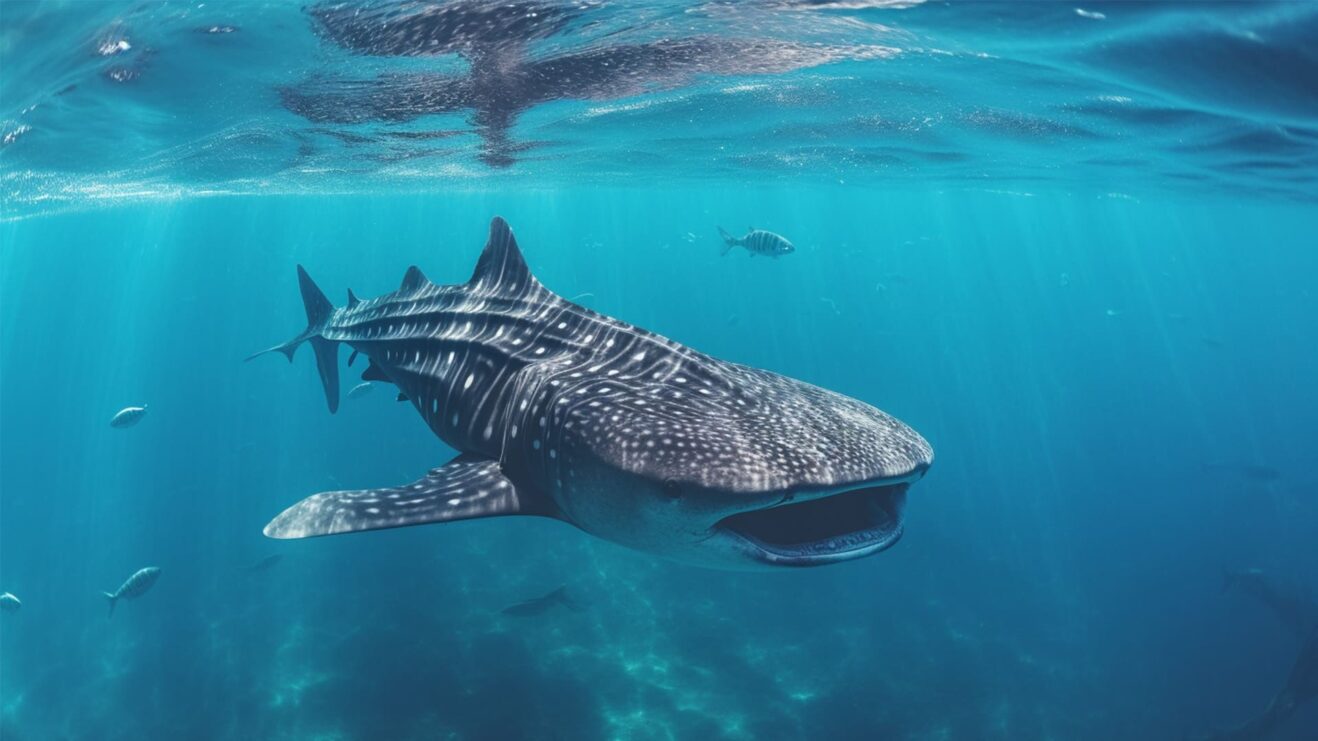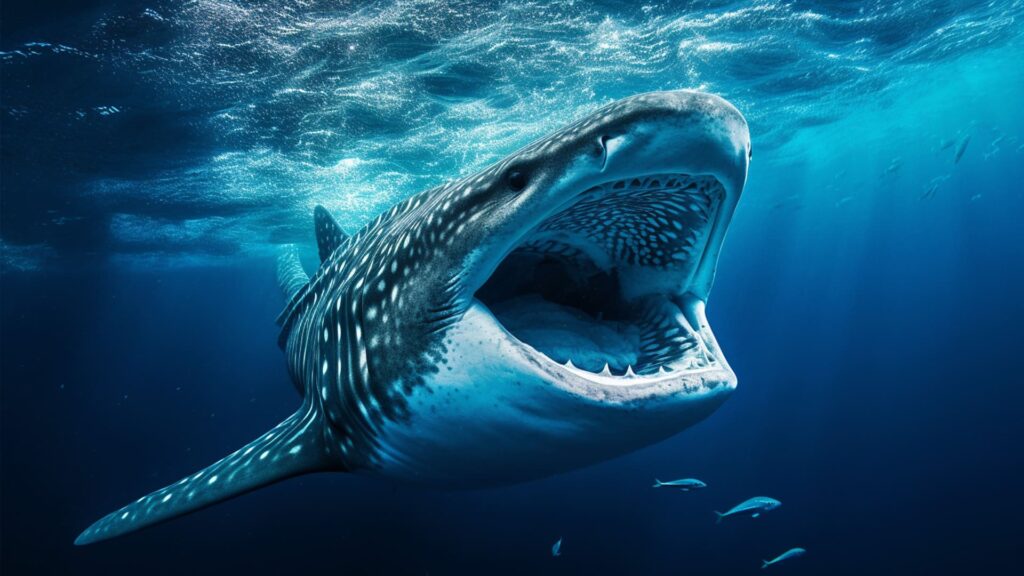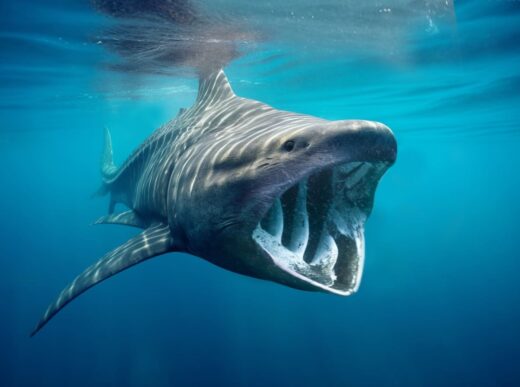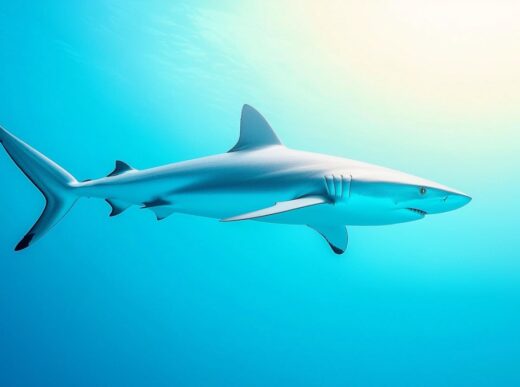Dive into the depths of the ocean with us, and we will reveal the intriguing world of whale sharks! The whale shark is a grandiose creature, the largest fish in the world, and it exhibits behaviour vastly different from its predatory counterparts. We’ve compiled 20 fun and fascinating facts that will help you see whale sharks in a whole new light. Join us on this underwater adventure as we unravel the mysteries of these awe-inspiring giants of the ocean!
20 Amazing Facts About Whale Sharks
So, get ready for an exciting journey through the mysterious waters where whale sharks reign supreme, and let’s explore the world of their amazing features.
Characteristics
1. So, picture this – the whale shark takes the crown as the largest shark on the planet and holds the title for the biggest fish cruising our oceans. We’re talking about a regular size of 12–13 meters, but some individuals go all out and stretch to a whopping 20 meters.
2. Now, imagine a shark with a head that’s not your typical pointy affair. The whale shark’s noggin is tiny and flat, with its jaws boldly stationed up front, not underneath like its shark buddies. And when it decides to snack, its mouth becomes a jaw-dropping 1.5 meters wide, forming a perfect «O».
3. Oh, and speaking of its mouth, it’s not just wide but clever too. When this shark decides to dine, it goes for the full scoop. Think of it as making a food net with that colossal mouth, allowing it to grab a huge volume of tasty treats.
4. Zoom in on those eyes – the whale shark’s got big peepers, almost the size of a golf ball at 5 centimetres in diameter. When trouble comes knocking, it has a nifty move, pulling its eyes inward and covering them with a fold of skin. Stealth mode activated!
5. Now, here’s a quirky fact – the whale shark is like the dental overachiever in the shark world, boasting up to 18,000 teeth arranged in a jaw-dropping 300 rows. But here’s the twist – these teeth are tiny, not even hitting the 6-millimeter mark.
6. Fashion-wise, the lower part of this shark’s body rocks a chic dirty white shade, while the back flaunts a stylish dark grey with spots and stripes. And get this – each whale shark’s spot pattern is as unique as a human fingerprint. Talk about oceanic individuality!
Habitats
7. Let’s talk vacation preferences – the whale shark is the ultimate sun-seeker, loving waters that never dip below a toasty +20 degrees Celsius. It’s in these warm havens that plankton, its favourite munchies, are in abundance.
8. If you’re wondering where these majestic creatures hang out, it’s a globetrotting adventure. From the Indian to the Atlantic and Pacific Oceans, they’re soaking up the sun between the northern and southern tropics. But here’s the catch – their squad is small no matter where they roam.
9. Now, if whale sharks were planning a reunion, you’d find them partying off the coasts of Taiwan, Southeast Africa, and Chile. Mozambique’s the real VIP spot, hosting one-fifth of the entire whale shark population. Talk about a whale of a good time!
Lifestyle
10. Picture this: the whale shark, a true champion in the longevity game among its shark cousins. Scientists have crunched the numbers and revealed that these majestic creatures can gracefully age to a staggering 130 years and beyond. It’s like the wise elder of the ocean, standing the test of time.
Eating habits
11. Now, when it comes to dining, the whale shark is the trendsetter among its shark peers. It’s not your typical carnivore – no, sir! In fact, scientists have granted it a VIP spot in a separate family, all because of its unique diet. This underwater trendsetter is the only shark that proudly wears the vegetarian label, with a plankton feast as its main course.
12. Have you ever wondered how this ocean giant manages its culinary affairs? It’s a bit like a refined whale dining experience. Imagine this: it opens its massive mouth, gracefully pulls in water, sifts it through its gills, and savors the plankton delicacies. And get this – in just one hour, a whale shark can effortlessly filter through a whopping 6,000 cubic meters of water. That’s like sipping through an entire swimming pool!
13. So, next time you see a whale shark enjoying its plankton buffet, just appreciate the sheer volume it can handle. It’s like watching a slow-motion magic trick – an underwater wizard turning a swimming pool’s worth of water into a feast fit for ocean royalty!
Intelligence and Social Behavior
14. Ever wondered about the social scene in the underwater realm? Well, the whale shark isn’t just a solo artist—it’s the lead singer in a gregarious band. Picture this: a bustling underwater party where the guest list boasts a higher number of males. It’s like the ocean’s very own social hotspot, where the whale shark takes center stage in a lively and communal lifestyle.
15. Now, let’s talk about the crew size. Typically, you’ll find a squad of 10 to 20 of these majestic creatures cruising through the ocean depths, creating an aquatic symphony of fins and tails. But hold on to your snorkels—there have been reports of legendary gatherings, epic underwater festivals where massive packs of up to 400 whale sharks have been spotted. It’s like a whale shark carnival, where the more, the merrier!
Reproduction
16. Alright, folks, prepare for a bit of underwater intrigue because when it comes to whale shark romance, it’s like solving a deep-sea puzzle. The details are a bit murky, but here’s the scoop: the scientific rumor mill suggests these giants might be oviparous, meaning their tiny tots develop in egg capsules. Now, the debate rages on – some think it happens in the womb, while others are placing their bets on egg capsules gracing the ocean floor. It’s like the ocean’s own guessing game!
17. Now, meet the little ones on the block – newborn whale sharks, pint-sized at only half a meter. These adorable mini-me versions take their sweet time growing up, embarking on a slow and steady journey to adulthood. We’re talking a whopping 30 years before they hit the big leagues of sexual maturity. It’s like the ocean’s version of an epic coming-of-age tale – a story of patience, growth, and underwater adventures!
Population
18. Okay, folks, here’s where it gets a bit tricky – the population size of whale sharks is like a well-guarded underwater secret. Some naysayers paint a gloomy picture, suggesting a slightly depressing number just above 1000 individuals. But hold on, most scientists are giving that estimate a solid eye roll, considering it a major lowball. It’s like trying to count the stars in the night sky – challenging and, let’s face it, a bit of a guessing game.
19. Now, onto a more serious note – the whale shark is donning the endangered species cape. Since 2016, it’s made its grand entrance into the prestigious International Red Book, and hunting these gentle giants is a big no-no in most countries. It’s like the oceanic VIP treatment, where whale sharks are getting the recognition and protection they rightfully deserve. So, let’s raise a virtual toast to the guardians of the sea!
Danger To Humans
20. Now, for all you ocean enthusiasts out there, here’s the lowdown – the whale shark is basically the gentle giant of the sea. With a diet focused on plankton and a leisurely pace, it’s not interested in turning humans into its lunch. It’s more into a chill, oceanic vibe.
However, and this is a big «however,» let’s not poke the giant underwater bear. An injured whale shark can unleash its inner fury, and trust me, you wouldn’t want to be on the receiving end of that powerful tail swipe. Imagine it as a warning sign, like «Hey, I’m not in the mood, back off.» So, let’s give our finned friend some space and keep the underwater dance harmonious!
Are There Any Aquariums with Whale Sharks?
Several aquariums around the world have housed or currently house whale sharks.
- Georgia Aquarium (USA):
- Website: Georgia Aquarium
- Osaka Aquarium Kaiyukan (Japan):
- Website: Osaka Aquarium Kaiyukan
- Churaumi Aquarium (Okinawa, Japan):
- Website: Churaumi Aquarium
- Dubai Aquarium & Underwater Zoo (UAE):
- Website: Dubai Aquarium & Underwater Zoo
- Adventure Aquarium (USA):
- Website: Adventure Aquarium
- Georgia Aquarium (USA):
Please note that the availability of whale sharks in aquariums can be subject to change, and it’s advisable to check the respective aquariums’ websites for the most up-to-date information before planning a visit. Additionally, there are ongoing discussions about the ethical implications of keeping large marine animals like whale sharks in captivity, so these considerations should be kept in mind when visiting such facilities.





